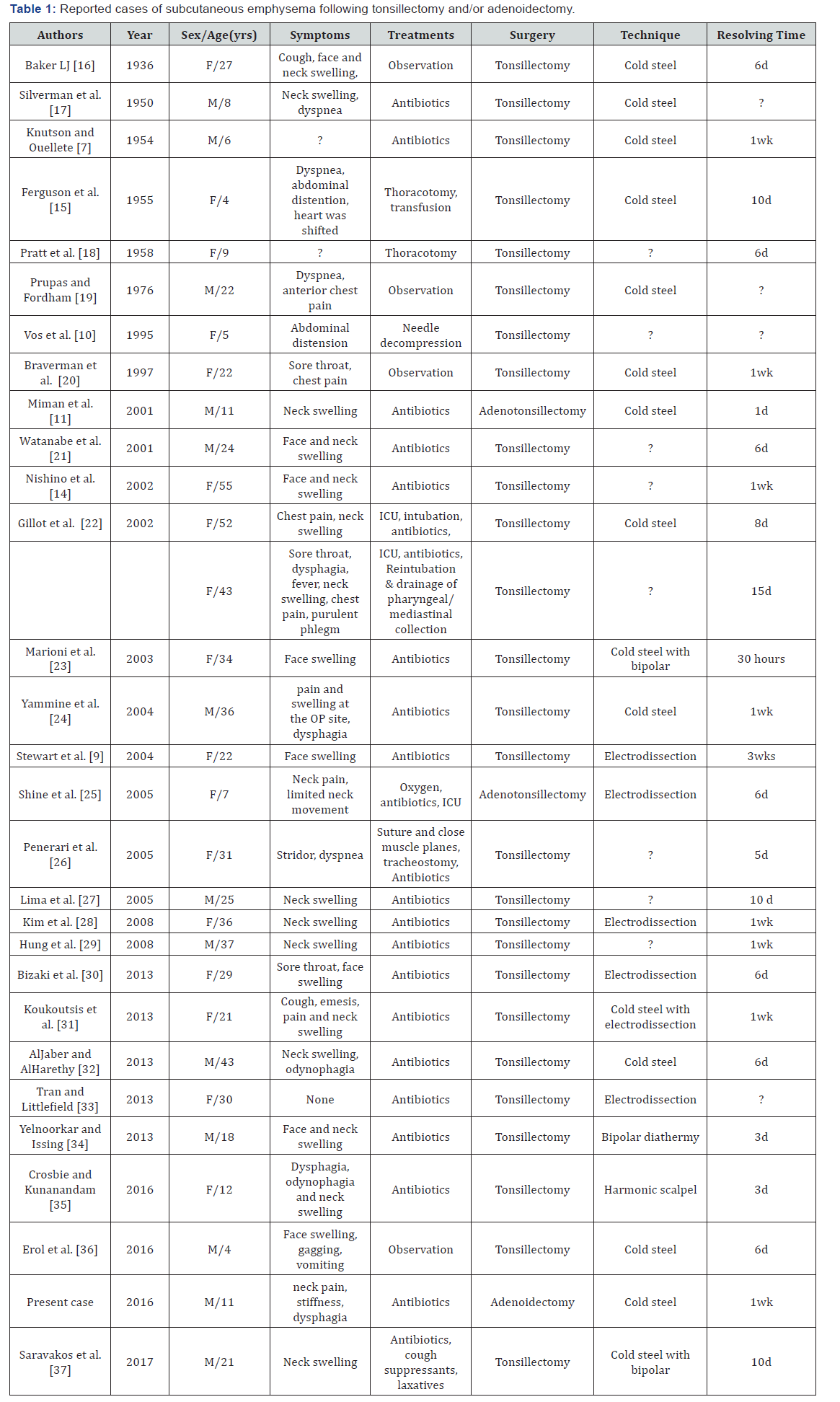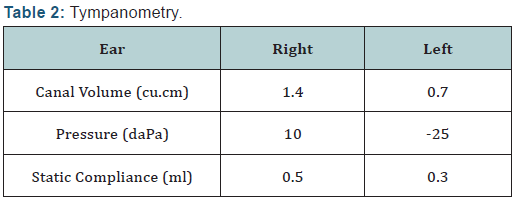Clinical Findings of Patients with Vestibular Schwannoma and Unilateral Tinnitus: A Case Study
Shreemanti Chakrabarty*
Doctor of Audiology, Southside Regional Medical Center, United States of America
Submission: December 16, 2016; Published: December 30, 2016
*Corresponding author: Shreemanti Chakrabarty, Doctor of Audiology, Southside Regional Medical Center, Petersburg VA 23805, USA
How to cite this article: Shreemanti C. Clinical Findings of Patients with Vestibular Schwannoma and Unilateral Tinnitus: A Case Study. Glob J Oto 2016; 2(5): 555600. DOI: 10.19080/GJO.2016.02.555600
Abstract
The symptoms, signs and clinical findings of a patient diagnosed with Vestibular Schwannoma with unilateral tinnitus are reviewed. The presence of the tumor was confirmed with Magnetic Resonance Imaging (MRI) to determine the size of the tumor. Correlation was found between the presence of hearing loss and subjective perception of tinnitus. Comprehensive diagnostic and vestibular testing was conducted to identify type and severity of hearing loss and vestibular weakness if any.
Introduction
Vestibular schwannomais found to occur in 10 per million of the population per year [1]. The tumor is generally sporadic and unilateral, 4% of vestibular schwannoma cases are bilateral with neurofibromatosis. The symptoms include hearing loss mostly unilateral, unilateral tinnitus, imbalance, facial numbness, headache, visual changes and otalgia [2]. There is not much information about the vertigo accompanying vestibular schwannoma. The hearing loss is generally progressive, high frequency with poor speech discrimination. Auditory brainstem response is pathologic in most cases. Caloric weakness and spontaneous nystagmus is usually found in VNG (videonystagmography). The quantity of deviant findings in these tests depend on the size of the tumor at the time of the examination. The diagnosis isconfirmed with imaging studies like magnetic resonance imaging (MRI).
Case Report
A 49 year old female with no medical history was seen by the ENT (Otolaryngologist or Ear Nose and Throat physician) due to a sudden hearing loss with right sided tinnitus associated with vertigo. Otoscopic examination was unremarkable for cerumen or middle ear infection [3]. Tympanometry revealed normal middle ear compliance, ear canal volume and tympanic membrane pressure. Pure tone audiometry revealed moderately severe sensorineural hearing loss in the right ear and normal hearing in the left ear. Tinnitus pitch and loudness matching was conducted to identify the specific characteristics of tinnitus and also to create information for a possible hearing aid fitting in the future. MRI revealed a tumor of size 0.66 mm in the right internal auditory canal [4,5]. Videonystagmography revealed aunilateral caloric weakness of 25% in the right ear. Considering all the clinical findings the patient was diagnosed with right sided vestibular schawannoma. The patient was scheduled for surgical removal of tumor after monitoring the tumor for the next six months since the size of the tumor was considered to be too small for excision.
Discussion
There has been a lot of research regarding the mechanisms of tinnitus generation in vestibular schwannoma which include cochlear dysfunction, compression of efferent fibers, cortical reorganization due to hearing loss among others. There was found to be a correlation between type and severity of hearing loss with subjective tinnitus. The right ear which was the worse ear in terms of hearing based on the audiogram had the tinnitus (Tables 1 & 2).

Conclusion
As clinicians we should be prepared to identify the clinical symptoms and test findings that coincide with vestibular schwannoma. There are easily identifiable audiologic and vestibular findings that will correlate with the diagnosis. Special attention should be paid during the hearing aid fitting considering changes in the size of the tumor and/or improvement in hearing after surgical removal of tumor.
References
- James J Nestor, Harold W Korol, Stephen L Nutik, Roderick Smith (1998) The incidence of acoustic neuroma (Letter) Arch Otolaryngol Head Neck Surg 114(6): 680.
- Evans DG, Huson SM, Donnai D, Neary W, Blair V, et al. (1992) A genetic study of type 2 neurofibromatosis in the United Kingdom, I: Prevalence, mutation rate, fitness and confirmation of maternal transmission effect on severity. J Med Genet 29(12): 841-846.
- Barrs DM, Brackmann DE, Olson JE, House WF (1985) Changing concepts of acoustic neuroma diagnosis. Arch Otolaryngol 111(1): 17- 21.
- Dornhoffer JL, Helms J, Hoehmann DH (1994) Presentation and diagnosis of small acoustic tumours. Otolaryngol Head Neck Surg 111(3 Pt 1): 232-235.
- Pensak ML, Glasscock ME, Josey AF, Jackson CG, Gulya AJ (1985) Sudden hearing loss and cerebellopontine angle tumors. Laryngoscope 95(10): 1188-1193.





























